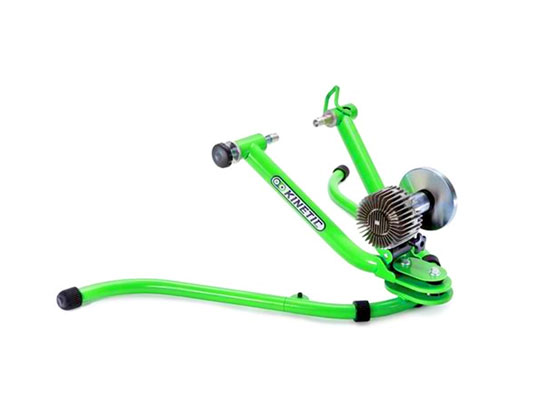Pivot Trainer
The pivot trainer, such as the Kinetic Rock ‘n Roll Trainer, is designed to simulate the natural feel of swaying or rocking from side to side while riding.
The main idea behind this design is to add a dynamic element to the indoor training experience, making it more closely resemble the movements and balance adjustments required when riding outdoors.
The pivot trainers typically feature a frame that allows for lateral movement, allowing the bike to tilt from side to side as you pedal. This movement engages your core muscles and helps to improve balance and stability while riding.
By incorporating this side-to-side motion, pivot trainers aim to provide a more realistic and engaging indoor training experience. They can be particularly beneficial for cyclists who want to improve their bike handling skills, core strength, and overall stability on the bike.
However, it’s important to note that the pivot trainer design may not be suitable or necessary for every cyclist.
It primarily caters to those who prioritize the simulation of outdoor riding dynamics and are looking for an enhanced training experience.
Additionally, the pivot mechanism adds complexity and may come at a higher cost compared to other types of trainers.
Ultimately, whether a pivot trainer is right for you depends on your specific training goals, preferences, and budget. It can be beneficial to try out a pivot trainer or watch videos of it in action to get a better sense of how it feels and if it aligns with your desired training experience.
| PROS Of The Pivot Trainer | CONS Of The Pivot Trainer |
|---|---|
|
|
The Case FOR a Pivot Trainer (Pros)
The pivot trainer, such as the Rock ‘n Roll Trainer by Kinetic, introduces a unique design that aims to closely replicate the natural motion and feel of swaying from side to side, mimicking the experience of riding outdoors.
This innovative feature enhances the overall training experience by providing a more realistic and engaging feel.
Improves Balance and Bike Handling Skills
By allowing the bike to sway from side to side, riders are challenged to maintain their balance and control, which translates to improved performance on the road.
This aspect of the pivot trainer is particularly advantageous for cyclists who want to enhance their technical skills and feel more confident when navigating challenging terrain.
Engages Different Muscle Groups
Additionally, the pivoting motion of the trainer engages different muscle groups compared to traditional stationary trainers. This means that not only are you working your legs and cardiovascular system, but you’re also activating your core muscles.
The constant adjustments required to maintain balance and stability on the pivoting trainer contribute to improved core strength and stability over time.
Reduces Strain on Joints and Muscles
Another advantage of the pivot trainer is its ability to reduce strain on joints and muscles. The swaying motion helps to absorb some of the impact and reduce the stress placed on the body, resulting in a smoother and more comfortable pedaling motion. This can be beneficial for individuals with joint issues or those looking for a low-impact training option.
Realistic Feel
Beyond the physical benefits, the pivot trainer offers a unique and immersive indoor cycling experience. The natural motion and realistic feel of swaying from side to side make workouts more enjoyable and motivating. It adds an element of excitement and engagement, making indoor training sessions feel closer to outdoor riding.
In summary, the pivot trainer provides a range of benefits, including improved balance and bike handling skills, enhanced core strength, reduced strain on joints and muscles, and an immersive indoor cycling experience. Whether you’re looking to fine-tune your skills or simply want to add variety and excitement to your training routine, the pivot trainer can be a valuable tool for cyclists of all levels.
The Case AGAINST a Pivot Trainer (Cons)
While the pivot trainer offers unique advantages, it’s important to consider some potential drawbacks before making a purchasing decision.
Higher Cost
One of the main concerns with the pivot trainer is its higher cost compared to traditional stationary trainers. The advanced design and additional components involved in creating the pivoting motion contribute to a higher price point. This can be a limiting factor for individuals on a tight budget or those who are not fully committed to investing in a premium trainer.
Steeper Learning Curve
Another consideration is the learning curve associated with the pivot trainer. The swaying motion introduces a different element to indoor cycling, requiring some adjustment and adaptation from riders. It may take some time to become accustomed to the feeling of riding on a pivoting trainer and maintaining balance throughout the workout. This learning curve can be challenging for beginners or individuals who prefer a more straightforward training experience.
Stability
In terms of stability, the pivot trainer may not provide the same level of rock-solid support as traditional stationary trainers. The pivoting motion introduces some degree of movement, which could potentially affect stability during intense or high-power efforts. While the trainer is designed to mimic the natural swaying motion, some riders may find it less stable or prefer the fixed stability of traditional trainers.
Motion
Additionally, the pivoting motion of the trainer may not be suitable for everyone. Individuals with certain physical conditions or limitations, such as balance issues or musculoskeletal injuries, may find the motion uncomfortable or potentially exacerbate their condition. It’s important to consider your specific needs and consult with a healthcare professional if you have any concerns regarding the suitability of a pivot trainer for your individual circumstances.
Limited Availability
Lastly, the availability of pivot trainers may be more limited compared to other types of stationary trainers. Due to their specialized design and niche market, finding a wide variety of pivot trainers from different brands or models might be challenging. This could limit your options when it comes to choosing a specific pivot trainer that meets your preferences and requirements.
While the pivot trainer offers unique benefits, it’s important to consider the higher cost, learning curve, potential stability issues, and suitability for individual needs before purchasing. Assessing these factors will help you make an informed decision and determine if the pivot trainer is the right choice for your indoor cycling training.
Pivot Trainer vs Smart Trainer
Pivot trainers and smart bike trainers are two different types of indoor bike trainers, each with its own unique features and benefits.
Pivot trainers are designed to simulate the natural side-to-side movement experienced during outdoor riding. With a pivoting feature, these trainers allow the bike to sway while pedaling, providing a more realistic and engaging riding experience. The motion simulation engages your core muscles, improving balance, stability, and core strength.
It replicates the feeling of riding on the road, offering a more immersive training session.
On the other hand, smart bike trainers offer a range of advanced features. Equipped with built-in sensors and technology, they track metrics such as speed, distance, power output, and cadence.
These trainers can wirelessly connect to training apps, software, and devices, enabling real-time monitoring and analysis of performance data.
One of the key advantages of smart trainers is interactive resistance control. They can automatically adjust the resistance based on the virtual terrain or training program, providing a dynamic and realistic riding experience that simulates outdoor conditions.
Additionally, smart trainers often come with companion apps or are compatible with popular training platforms, offering features like virtual routes, training plans, multiplayer modes, and virtual racing. They seamlessly integrate with training software such as Zwift, TrainerRoad, or Sufferfest, allowing you to join virtual group rides, structured workouts, and interactive training sessions with cyclists from around the world.
Pivot trainers focus on replicating natural bike movement and engaging the core muscles, while smart trainers offer advanced connectivity, data tracking, and interactive features. The choice between the two depends on your preferences, training goals, and desired riding experience.

